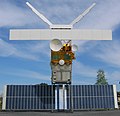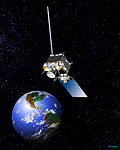Top-Fragen
Zeitleiste
Chat
Kontext
Liste von Erdbeobachtungssatelliten
Aus Wikipedia, der freien Enzyklopädie
Remove ads
Dies ist eine Liste von Erdbeobachtungssatelliten. Sie gibt eine kleine Auswahl der tatsächlich gestarteten Satelliten wieder.
Chronologische Übersicht
Remove ads
Geordnet nach Fernerkundungsinstrument
Nichtabbildende aktive Systeme
Mikrowellenaltimeter (Höhenmesser): Fernerkundung der Meeresoberfläche
- 1975 – GEOS 3 (erstes Satelliten-Altimeter)
- 1978 – Seasat (bis 10. Oktober 1978)
- 1985 – Geosat
- 1991 – ERS-1 (bis 10. März 2000), (Altimeter = Hauptmessgerät)
- 1992 – TOPEX/Poseidon (bis 18. Januar 2006), (Altimeter = Hauptmessgerät)
- 1995 – ERS-2 (Altimeter = Hauptmessgerät)
- 1998 – GFO (Geosat Follow-On) Nachfolger von Geosat
- 2001 – Jason-1 (Nachfolger von TOPEX/Poseidon), (Altimeter = Hauptmessgerät)
- 2002 – Envisat (Nachfolger von ERS)
- 2008 – Jason-2
- 2010 – CryoSat-2
Laser Altimeter
- 2003 – ICESat, Geoscience Laser Altimeter System (GLAS)
LIDAR: Erforschung von Wolken und Aerosolen
- 2006 – CALIPSO, Cloud-Aerosol Lidar with Orthogonal Polarization (CALIOP)
- 2018 – ADM-Aeolus, Atmospheric Laser Doppler Lidar Instrument (ALADIN)
- 2024 – EarthCARE, Backscatter Lidar (ATLID)
Scatterometer (Streustrahlungsmesser): Erforschung von Luftbewegungen über dem Meer
Abbildende aktive Systeme
Radar mit synthetischer Apertur (SAR)
- 1978 – Seasat (bis 10. Oktober 1978)
- 1987 – Kosmos 1870 (Almaz-T2/Resurs-R)
- 1991 – Almaz 1 (Almaz-T3/Resurs-R)
- 1991 – ERS-1 (bis 10. März 2000), Active Microwave Instrument (AMI)
- 1992 – JERS-1 (bis 1998)
- 1995 – ERS-2, Active Microwave Instrument (AMI)
- 1995 – RADARSAT-1
- 2002 – Envisat, Advanced Synthetic Aperture Radar (ASAR)
- 2007 – TerraSAR
Abbildende passive Systeme
Hyperspektrale Scanner (Spektrometer mit ca. 15 bis 200 Spektralbändern)
- 1999 – Terra, MODIS (= Moderate-Resolution Imaging Spectroradiometer), 36 Spektralbänder
- 2000 – EO-1, Hyperion, 220 Spektralbänder
- 2001 – Proba-1, CHRIS, 60 Spektralbänder
- 2002 – Envisat, MERIS (MEdium Resolution Imaging Specrometer), 15 Spektralbänder
- 2002 – Aqua, MODIS (=Moderate-Resolution Imaging Spectroradiometer), 36 Spektralbänder
- 2019 – Prisma, 239 Spektralbänder
- 2022 – EnMAP, 200 Spektralbänder
Multispektrallinienscanner zur Messung der Ozeanfarbe (global)
- 1978 – Nimbus-7, Coastal Zone Color Scanner (CZCS) bis 1986
- 1996 – IRS P3, Modularer Optischer Scanner (MOS) bis 2004
- 1996 – ADEOS-I (Midori), Ocean Color and Temperature Scanner (OCTS) bis 1997
- 1997 – Orbview-2 (Seastar), Sea-viewing Wide Field-of-view Sensor (SeaWiFS)
- 2002 – Envisat, MEdium Resolution Imaging Specrometer (MERIS)
- 2002 – Aqua, Moderate-Resolution Imaging Spectroradiometer (MODIS)
- 2016, 2018 – Sentinel-3, Ocean and Land Colour Instrument (OLCI)
Remove ads
Beispiele nach Untersuchungsthema

Untersuchung des Strahlungshaushalts der Erde
- 1978 – Nimbus 7, Earth Radiation Budget Instrument (ERB)
- 1984 – Earth Radiation Budget Satellite (ERBS), Earth Radiation Budget Experiment (ERBE)
- 1984 – NOAA-9, Earth Radiation Budget Experiment (ERBE)
- 1986 – NOAA-10, Earth Radiation Budget Experiment (ERBE)
- 1994 – Meteor 3-06, ScaRaB
- 1997 – TRMM, Clouds and the Earth's Radiant Energy System (CERES)
- 1999 – Terra, Clouds and the Earth's Radiant Energy System (CERES)
- 2002 – Aqua, Clouds and the Earth's Radiant Energy System (CERES)
- 2002 – Meteosat-8 (MSG-1), Geostationary Earth Radiation Budget (GERB)
- 2005 – Meteosat-9 (MSG-2), Geostationary Earth Radiation Budget (GERB)
Untersuchung der Ozonschicht
- 1975 – Explorer 55 (Atmosphere Explorer-E), Backscatter UV Spectrometer
- 1978 – Nimbus 7, Total Ozone Mapping Spectrometer (TOMS)/Solar Backscatter Ultraviolet instrument (SBUV)
- 1981 – SME (Solar Mesosphere Explorer)
- 1983 – Advanced Tiros N / NOAA 8, Solar Backscatter Ultraviolet Radiometer (SBUV), (auch auf nachfolgenden NOAA-Satelliten)
- 1991 – Upper Atmosphere Research Satellite (UARS)
- 1991 – METEOR 3-05, Total Ozone Mapping Spectrometer (TOMS)
- 1995 – ERS-2, Global Ozone Monitoring Experiment (GOME)
- 1996 – Earth Probe, Total Ozone Mapping Spectrometer (TOMS)
- 1996 – ADEOS I (Midori), Total Ozone Mapping Spectrometer (TOMS)
- 2002 – Envisat, Global Ozone Monitoring by Occultation of Stars (GOMOS)
- 2003 – SCISAT
- 2004 – Aura, Ozone Monitoring Instrument (OMI)
- 2006 – MetOp-A, Global Ozone Monitoring Experiment-2 (GOME-2)
Untersuchung der Aerosoldichte der Atmosphäre
- 1978 – TIROS-N, Advanced Very High Resolution Radiometer (AVHRR)
- 1978 – Nimbus 7, Total Ozone Mapping Spectrometer (TOMS) (weitere Satelliten mit TOMS s. o.)
- 1981 – NOAA-7, Advanced Very High Resolution Radiometer (AVHRR-2) (weitere 10 Satelliten mit AVHRR bis 2002)
- 1991 – ERS-1, Along Track Scanning Radiometer (ATSR)
- 1995 – ERS-2, Advanced Along Track Scanning Radiometer (AATSR)
- 1996 – ADEOS I (Midori), POLDER (erster Satellitensensor speziell für Messungen von Aerosolen)/ OCTS
- 1999 – Terra, CERES, MISR, MODIS
- 2002 – ADEOS-II (Midori-II), Global Imager (GLI)
Chemische Zusammensetzung der oberen Atmosphäre
- 1978 – Nimbus 7, Stratospheric Aerosol Mission (SAM II)
- 1979 – Applications Explorer Mission-2 (AEM-2), Stratospheric Aerosol and Gas Experiment (SAGE)
- 1984 – Earth Radiation Budget Satellite (ERBS), SAGE II
- 1991 – Upper Atmosphere Research Satellite (UARS)
- 1999 – Terra, Measurements Of Pollution In The Troposphere sensor (MOPITT)
- 2001 – Sage III / METEOR 3M – SAGE III
- 2002 – Envisat, Scanning Imaging Absorption Spectrometer for Atmospheric Cartography (SCIAMACHY)
Weitere Parameter
- globale Niederschlagsrate: Tropical Rainfall Measuring Mission (nur Tropen), Global Precipitation Measurement
- Salzgehalt des oberflächennahen Meerwassers: Soil Moisture and Ocean Salinity, Aquarius
- Bodenfeuchtigkeit: Soil Moisture and Ocean Salinity
- globale Blitzortung: MicroLab-1, Optical Transient Detector (OTD); TRMM, Lightning Imaging Sensor (LIS); GOES-R, Geostationary Lightning Mapper (GLM); Lightning Mapper Sensor (LMS)
Remove ads
Siehe auch
- Earth Observing System der NASA
- Earth Explorer Missions Programm der ESA
Weblinks
- Astrium Satellitendatenportfolio
- Lexikon der Fernerkundung
- eduspace der ESA
- ESA Earth Observation Handbook
- science@nasa-earth (englisch)
- Übersicht bei Gunter's Space Page (englisch)
- Tabelle von Regional Planetary Image Facility (RPIF): Missionen zur Erde
- NASA Earth Observatory Homepage:
- Liste der Erdbeobachtungssatelliten bei ESA eoPortal
- EARSC - European Association of Remote Sensing Companies
Remove ads
Wikiwand - on
Seamless Wikipedia browsing. On steroids.
Remove ads















































